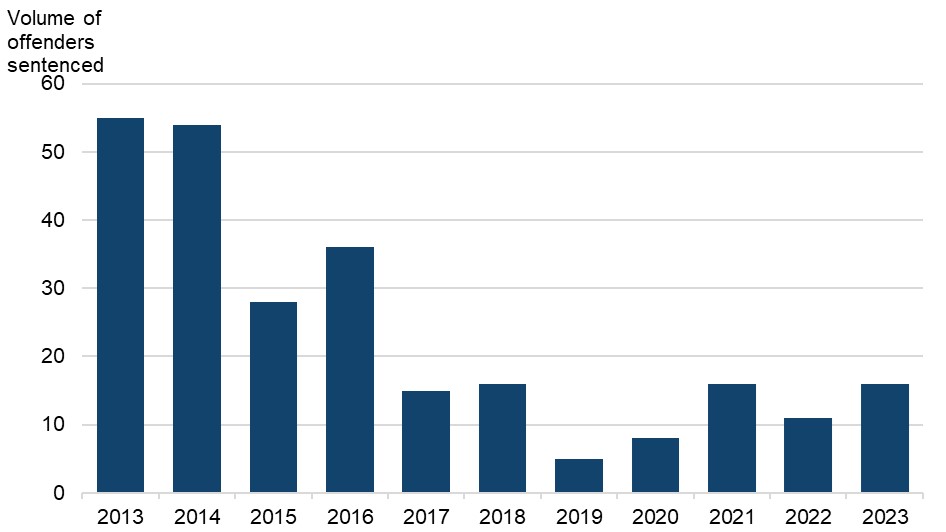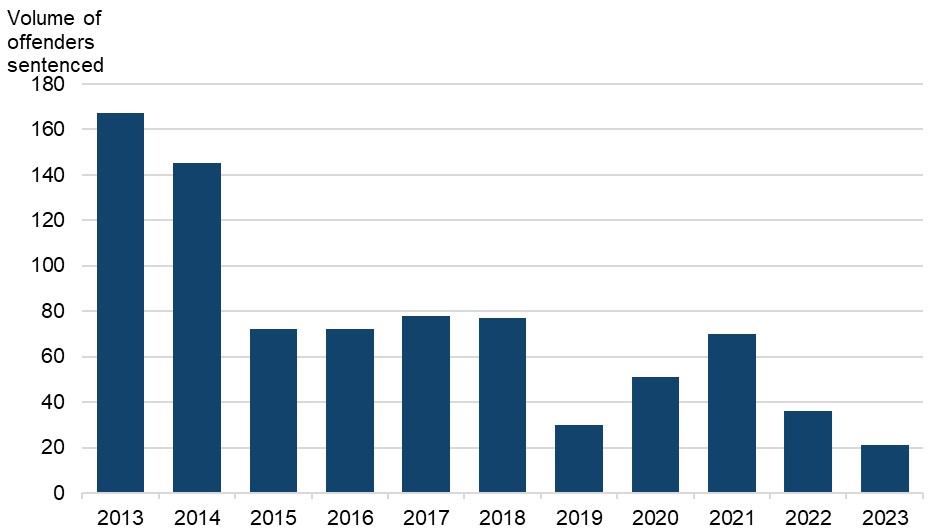Introduction
This statistical summary provides information on volumes and sentence outcomes for adult offenders (aged 18 or over at the time of conviction) sentenced for offences covered by the Sentencing Council’s draft Hare coursing guideline.
There is one draft guideline proposed covering the following offences:
- Taking or destroying game by night, Night Poaching Act 1828 (section 1)
- Trespassing in the daytime in search of game, Game Act 1831 (section 30)
- Trespassing with intent to search for or to pursue hares with dogs etc, Police, Crime, Sentencing and Courts Act 2022 (section 63)
- Being equipped for searching for or pursuing hares with dogs etc, Police, Crime, Sentencing and Courts Act 2022 (section 64)
There are no existing guidelines for any of these offences.
The Court Proceedings Database (CPD), maintained by the Ministry of Justice, is the data source for this summary. For more information on this data source please see the ‘Further information’ section at the end of this document.
Additional figures for this offence, including breakdowns by demographic groups (sex, age group and ethnicity), can be found in the data tables which are available to download as Open Document spreadsheets on the Sentencing Council: Publications webpage.
Taking or destroying game by night
Sentence volumes
Taking or destroying game by night is a low volume offence, with around 20 offenders sentenced in 2023 (Figure 1). Volumes of offenders sentenced for this offence sharply declined in 2015, and then again in 2017. From 2017 onwards, volumes of offenders sentenced have fluctuated, but have remained consistently below 20 offenders each year. This offence is summary only, and all offenders were sentenced in the magistrates’ courts.
Figure 1: Number of adult offenders sentenced for taking or destroying game by night, 2013 to 2023

Sentence outcomes
As of 1 August 2022, the statutory maximum sentence for this offence increased from a fine to 6 months’ custody; however no offenders received immediate custody in either 2022 or 2023. Across 2013 to 2023, the most common sentence outcome was a fine. In 2023, all adult offenders were sentenced to a fine.
For adult offenders who received a fine in 2023, the average (median) fine value was £323 after any reduction for a guilty plea. Half of fines received by adult offenders for this offence were up to and including £250, and a quarter were between £250 and £500.
Trespassing in the daytime in search of game
Sentence volumes
The volume of offenders sentenced for trespassing in the daytime in search of game sharply declined in 2015, and again in 2019 (Figure 2). Since then, volumes have fluctuated, but around 20 offenders were sentence to this offence in 2023. This offence is summary only, and in 2023 all offenders were sentenced in the magistrates’ courts.
Figure 2: Number of adult offenders sentenced for trespassing in the daytime in search of game, 2013 to 2023
Sentence outcomes
As of 1 August 2022, the statutory maximum sentence for this offence increased from a fine to 6 months’ custody; however no offenders received immediate custody in either 2022 or 2023. The majority of offenders received a fine between 2013 to 2023. In 2023, all offenders sentenced for trespassing in the daytime in search of game received a fine.
In 2023, offenders sentenced to a fine received an average (median) fine value of £150 after any reduction for a guilty plea. In 2023, around three quarters (76 per cent) of offenders received a fine of up to and including £250.
Trespassing with intent to search for or to pursue hares with dogs etc
Sentence volumes
In 2023, around 30 offenders were sentenced for trespassing with intent to search for or to pursue hares with dogs etc. The offence came into force on 1 August 2022, but no offenders were sentenced in 2022. This offence is summary only and all offenders were sentenced in the magistrates’ courts.
Sentence outcomes
The statutory maximum sentence for this offence is 6 months’ custody. However no offenders have received immediate custody since it came into force.
In 2023, 75 per cent of offenders sentenced for this offence received a fine. A further 18 per cent received a community sentence. Around 4 per cent received an absolute or conditional discharge, and the remaining 4 per cent received a suspended sentence.
In 2023, offenders sentenced to a fine received an average (median) fine value of £500 after any reduction for a guilty plea. In 2023, around half (52 per cent) of offenders received a fine between £250 and £500, and a further 29 per cent received a fine of up to and including £250.
Being equipped for searching for or pursuing hares with dogs etc
Sentence volumes
In 2023, fewer than 10 offenders were sentenced for being equipped for or pursuing hares with dogs etc. The offence also came into force on 1 August 2022, but no offenders were sentenced in 2022. This offence is summary only and all offenders were sentenced in the magistrates’ courts.
Sentence outcomes
The statutory maximum sentence for this offence is 6 months’ custody; however no offenders have received an immediate custodial sentence since it came into force.
In 2023, 43 per cent (this equates to fewer than 5 offenders) of offenders sentenced for this offence received a suspended sentence. A further 43 per cent received a community sentence, and the remaining offenders received a fine (14 per cent).
Further information
Volumes of sentences
The data presented in this summary only include cases where the offence detailed was the principal offence committed. When an offender has been found guilty of two or more offences, the principal offence is the offence for which the heaviest penalty is imposed. Where the same disposal is imposed for two or more offences, the offence selected is the offence for which the statutory maximum penalty is the most severe. Although the offender will receive a sentence for each of the offences that they are convicted of, it is only the sentence for the principal offence that is presented in this summary.
Sentence outcomes
The outcomes presented are the final sentence outcomes, after taking into account all factors of the case, including whether a guilty plea was made. This is because the sentence length information available in the Court Proceedings Database (CPD) is the final sentence imposed, after any reduction for guilty plea. Sentence outcomes presented in this summary are therefore not directly comparable to outcomes in the sentencing guideline tables, which instead show starting point sentences before a guilty plea has been entered.
General conventions
Actual numbers of sentences have been rounded to the nearest 100, when more than 1,000 offenders were sentenced, and to the nearest 10 when fewer than 1,000 offenders were sentenced.
Proportions of sentencing outcomes have been rounded to the nearest integer. Percentages in this report may not appear to sum to 100 per cent, due to rounding.
Data sources and quality
The CPD, maintained by the Ministry of Justice (MoJ), is the data source for these statistics. Every effort is made by MoJ and the Sentencing Council to ensure that the figures presented in this publication are accurate and complete. However, it is important to note that these data have been extracted from large administrative data systems generated by the courts and police forces. As a consequence, care should be taken to ensure data collection processes and their inevitable limitations are taken into account when those data are used.
Work has been undertaken by MoJ to develop and deliver improvements to the criminal court sentencing data, these new processes affect data from 2017 onwards, therefore care should be taken when comparing trends between 2017 and 2016. Further information on this can be found in the ‘Technical Guide to Criminal Justice Statistics’ within the Criminal Justice System Statistics Quarterly (CJSQ) publication.
The average fine amounts presented in this statistical summary are median average fines, after any reduction for guilty plea. The median average fine is calculated by ordering all the fine values (from lowest to highest, or highest to lowest) and choosing the middle value. The median fine has been provided because the median is less sensitive to extreme values and the volumes of offenders sentenced for these offences is low. The mean fine value is calculated by adding up all of the fine values and dividing the total by the number of offenders sentenced to a fine.
The result category ‘Other/unknown’ includes cases where the outcome categorised in the CPD was ‘Otherwise dealt with’, which covers multiple miscellaneous disposals, and those cases where the disposal was not known.
Figures presented include the time period from March 2020 in which restrictions were initially placed on the criminal justice system due to the coronavirus (COVID-19) pandemic, and the ongoing courts’ recovery since. It is therefore possible that these figures may reflect the impact of the pandemic on court processes and prioritisation and the subsequent recovery, rather than a continuation of the longer-term series, so care should be taken when interpreting these figures.
Contact points for further information
We would be very pleased to hear your views on our statistical summaries. If you have any feedback or comments, please send them to:
Statistical contact: research@sentencingcouncil.gov.uk
Press Office enquiries: pressofficesentencingcouncil@sentencingcouncil.gov.uk
Further information on the Sentencing Council and its work can be found on the Sentencing Council webpage.
